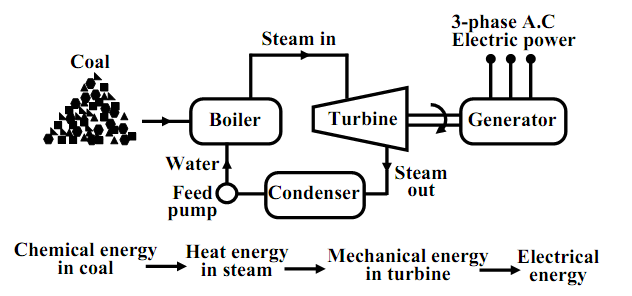Thermal plant
To generate voltage at 50 Hz we have to run the generator at certain rpm by some external agency. A turbine is employed to rotate the generator. Turbine might be of two types, namely water turbine and steam turbine. In a thermal power station coal is burnt to generate steam that in turn, drives the steam turbine therefore the generator (i.e., turbo set). In the figure below the elementary features of a thermal power plant is illustrated.
In a thermal power plant coil is burnt to generate high temperature and high pressure steam in a boiler. The steam is passed via steam turbine to generate rotational motion. The generator, mechanically coupled to the turbine, therefore rotates generating electricity. The chemical energy stored in coal after a couple of transformations generates electrical energy at the generator terminals as shown in the figure. Therefore proximity of a generating station closer to a coal reserve and water sources will be very economical as the cost of transporting coal gets decreased. In our country coal is available in plenty and naturally thermal power plants are very popular. Though, these plants pollute the atmosphere since of burning of coals.

Figure: Basic components of a thermal generating unit.
Severe conditions (like use of more chimney heights all along with the compulsory use of electrostatic precipitator) are place by regulatory authorities to observe that the effects of pollution are reduced. A large quantity of ash is generated each day in a thermal plant and efficient handling of the ash adds to the running cost of the plant. Nevertheless 57% of the production in our country is from thermal plants. The speed of alternator employed in thermal plants is 3000 rpm that means 2-pole alternators are employed in such plants.